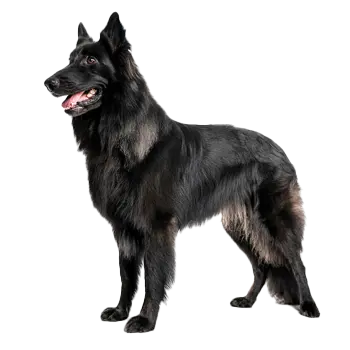The Belgian Shepherd Groenendael is generally considered a healthy and robust breed, developed through generations of selection for hardiness and working ability. With proper care, nutrition, and regular veterinary attention, Groenendaels typically enjoy a lifespan of 12 to 14 years, with some individuals living even longer. Their breeding history as functional working dogs has contributed to their overall soundness, though like all purebred dogs, they can be predisposed to certain hereditary health conditions that responsible breeders work to minimize through health testing and selective breeding.
Hip dysplasia is a condition that can affect Groenendaels, occurring when the hip joint develops abnormally, leading to arthritis and pain over time. Responsible breeders screen their breeding stock through radiographic evaluation certified by organizations such as the Orthopedic Foundation for Animals. While hip dysplasia has a hereditary component, environmental factors such as rapid growth during puppyhood, obesity, and excessive exercise in young dogs can influence its development. Maintaining appropriate body weight throughout the dog's life and avoiding overexercise during growth periods can help reduce risk.
Elbow dysplasia is another orthopedic condition seen in the breed, involving abnormal development of the elbow joint that can cause lameness and arthritis. Like hip dysplasia, elbow dysplasia is hereditary and can be screened through radiographic evaluation. Breeders who test their dogs and select against affected individuals help reduce the incidence in future generations. Progressive retinal atrophy, a group of genetic diseases that cause gradual deterioration of the retina leading to vision loss and eventual blindness, can occasionally affect Groenendaels. Regular ophthalmologic examinations and genetic testing can help identify carriers and affected dogs.
Epilepsy, a neurological condition causing seizures, is reported in the breed though it is not extremely common. Seizures can range from mild to severe and may require lifelong management with medication. The exact inheritance pattern of epilepsy in dogs is complex and not fully understood. Eye problems including cataracts can develop in some Groenendaels, particularly as they age. Regular eye examinations by a veterinary ophthalmologist can help detect issues early. Some individuals may develop skin allergies that can cause itching, hair loss, and discomfort, often managed through diet adjustments, supplements, or medication.
Cancer can affect Groenendaels as they age, as with many dog breeds. While there are no specific cancer types uniquely associated with the breed, maintaining overall health, appropriate body weight, and regular veterinary monitoring helps with early detection. Bloat, or gastric dilatation-volvulus, is a life-threatening emergency that can affect deep-chested breeds like the Groenendael. This condition occurs when the stomach fills with gas and potentially twists, cutting off blood flow. Symptoms include a distended abdomen, restlessness, attempted vomiting without production, and distress. This requires immediate emergency veterinary care.
Preventive care is essential for maintaining a Groenendael's health throughout their life. Regular veterinary check-ups, ideally twice yearly, allow for early detection of developing issues. Vaccinations should be kept current according to your veterinarian's recommendations and your dog's lifestyle. Parasite prevention including heartworm preventive medication, flea and tick control, and regular deworming is important. Dental care is often overlooked but crucial for overall health; regular teeth brushing and professional cleanings help prevent periodontal disease that can affect systemic health.
Maintaining an appropriate body weight is one of the most important things owners can do for their Groenendael's long-term health. Obesity places stress on joints, increases the risk of various diseases, and can shorten lifespan. Feed a high-quality diet appropriate for the dog's age, activity level, and individual metabolism. Regular exercise not only helps maintain healthy weight but also supports cardiovascular health, joint health, and mental well-being. Screening for genetic conditions through health testing, particularly when selecting breeding stock, helps maintain the breed's overall health. Prospective owners should ask breeders about health clearances for hips, elbows, and eyes at minimum.
Common Health Issues
- Hip dysplasia is a condition that can affect Groenendaels, occurring when the hip joint develops abnormally, leading to arthritis and pain over time.
- While hip dysplasia has a hereditary component, environmental factors such as rapid growth during puppyhood, obesity, and excessive exercise in young dogs can influence its development.
- Like hip dysplasia, elbow dysplasia is hereditary and can be screened through radiographic evaluation.
- Epilepsy, a neurological condition causing seizures, is reported in the breed though it is not extremely common.
- The exact inheritance pattern of epilepsy in dogs is complex and not fully understood.
- Eye problems including cataracts can develop in some Groenendaels, particularly as they age.
Preventive Care & Health Monitoring
- With proper care, nutrition, and regular veterinary attention, Groenendaels typically enjoy a lifespan of 12 to 14 years, with some individuals living even longer.
- While hip dysplasia has a hereditary component, environmental factors such as rapid growth during puppyhood, obesity, and excessive exercise in young dogs can influence its development.
- Maintaining appropriate body weight throughout the dog's life and avoiding overexercise during growth periods can help reduce risk.
- While there are no specific cancer types uniquely associated with the breed, maintaining overall health, appropriate body weight, and regular veterinary monitoring helps with early detection.
Regular veterinary check-ups and preventive care are essential for maintaining your Belgian Shepherd Groenendael's health and longevity.

